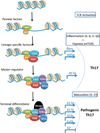The IL-23-IL-17 immune axis: from mechanisms to therapeutic testing
- PMID: 25145755
- PMCID: PMC4281037
- DOI: 10.1038/nri3707
The IL-23-IL-17 immune axis: from mechanisms to therapeutic testing
Abstract
Following the discovery of T helper 17 (TH17) cells, the past decade has witnessed a major revision of the TH subset paradigm and substantial progress has been made in deciphering the molecular mechanisms of T cell lineage commitment and function. In this Review, we focus on the recent advances that have been made regarding the transcriptional control of TH17 cell plasticity and stability, as well as the effector functions of TH17 cells, and we highlight the mechanisms of IL-17 signalling in mesenchymal and barrier epithelial tissues. We also discuss the emerging clinical data showing that IL-17-specific and IL-23-specific antibody treatments are remarkably effective for treating many immune-mediated inflammatory diseases.
Figures
References
-
-
Cua DJ, et al. Interleukin-23 rather than interleukin-12 is the critical cytokine for autoimmune inflammation of the brain. Nature. 2003;421:744–748. • This study shows IL-23 controls a key check point for induction of autoimmune inflammation.
-
-
- Oppmann B, et al. Novel p19 protein engages IL-12p40 to form a cytokine, IL-23, with biological activities similar as well as distinct from IL-12. Immunity. 2000;13:715–725. - PubMed
-
- Kastelein RA, Hunter CA, Cua DJ. Discovery and biology of IL-23 and IL-27: related but functionally distinct regulators of inflammation. Annual review of immunology. 2007;25:221–242. - PubMed
-
-
Langrish CL, et al. IL-23 drives a pathogenic T cell population that induces autoimmune inflammation. The Journal of experimental medicine. 2005;201:233–240. • This is the first study to suggest IL-17-producing cells are critical mediators of autoimmunity, which led to proposal of the Th17 hypothesis.
-
Publication types
MeSH terms
Substances
Grants and funding
LinkOut - more resources
Full Text Sources
Other Literature Sources
Medical
Miscellaneous





